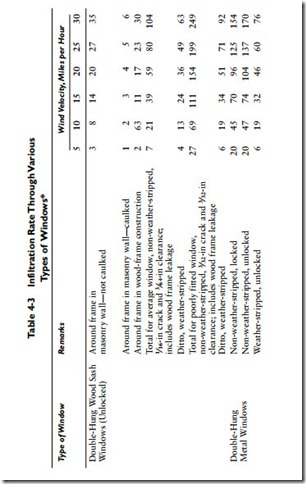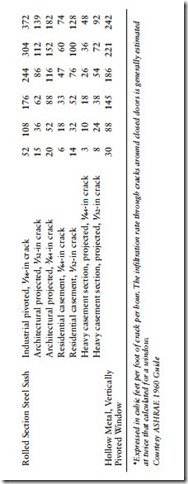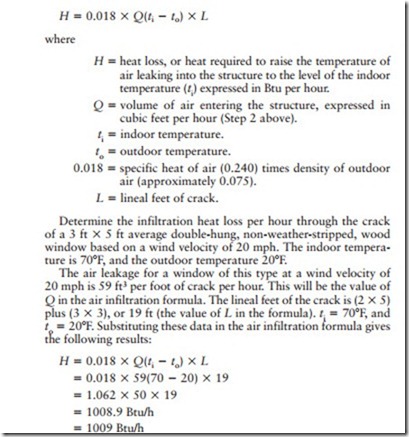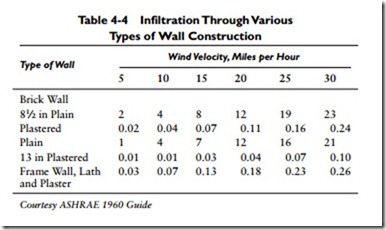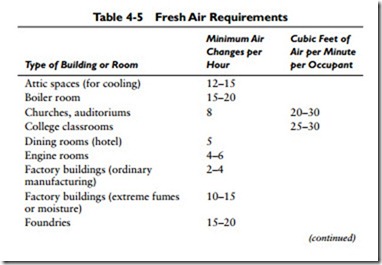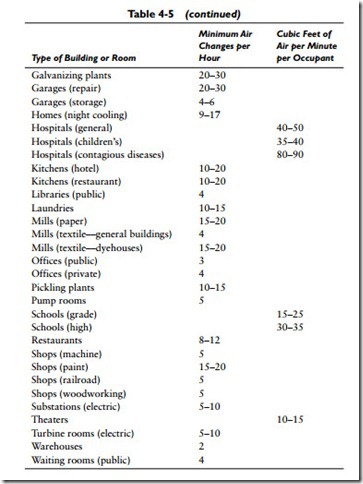Loss in Slab Construction
The heat loss for houses and small buildings constructed on a concrete slab at or near grade level is computed on the basis of heat loss per foot of exposed edge. For example, a concrete slab measuring 20 ft X 25 ft would have an exposed edge of 90 ft. This represents the measurement completely around the perimeter of the exposed edge of the slab. The heat loss will depend upon the
thickness of insulation along the exposed edge and the outside design temperature range. This type of information is available from ASHRAE publications. To obtain the heat loss in Btu/h, sim- ply multiply the total length of exposed edge by the heat loss in Btu/h per lineal foot (lin ft). For example, a 90-ft exposed edge with 2-in-edge insulation at an outdoor design temperature of 35° would be calculated as follows:
90 lin ft X 45 Btu/h/lin ft = 4050 Btu/h
Infiltration Heat Loss
During the heating season, a portion of heat loss is due to the infiltration of cooler outside air into the interior of the structure through cracks around doors and windows and other openings that are not a part of the ventilating system. The amount of air entering the structure by infiltration is important in estimating the requirements of the heating system, but the composition of this air is equally important.
A pound of air is composed of both dry air and moisture particles, which are combined (not mixed) so that each retains its individual characteristics. The distinction between these two basic components of air is important, because each is involved with a different type of heat: dry air with specific heat, and moisture content with latent heat.
The heating system must be designed with the capability of warming the cooler infiltrated dry air to the temperature of the air inside the structure. The amount of heat required to do this is referred to as the sensible heat loss and is expressed in Btu/h. The two methods used for calculating heat loss by air infiltration are:
(1) the crack method, and (2) the air-change method.
The Crack Method
The crack method is the most accurate means of calculating heat loss by infiltration, because it is based on actual air leakage through cracks around windows and doors and takes into consideration the expected wind velocities in the area in which the structure is located. The air-change method (see below) does not consider wind velocities, which makes it a less accurate means of calculation.
Calculating heat loss by air infiltration with the crack method involves the following basic steps:
1. Determine the type of window or door (see Table 4-3).
2. Determine the wind velocity and find the air leakage from Table 4-3.
3. Calculate the lineal feet of crack.
4. Determine the design temperature difference.
The data obtained in these four steps are used in the following formula:
Table 4-4 represents a typical wall infiltration chart for a number of different types of wall construction. Like the air infiltration rate through windows, it is also based on wind velocity (see Table 4-3).
Air-Change Method
In the air-change method, the amount of air leakage (i.e., infiltration) is calculated on the basis of an assumed number of air changes per hour per room. The number of air changes will depend upon the type of room and the number of walls exposed to the outdoors. Table 4-5 is an example of a typical air-change chart used in the air- change method.
